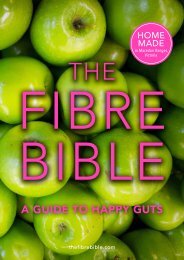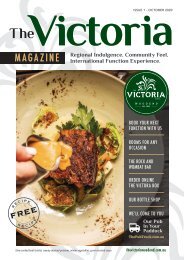Made Kindly Magazine by Zig Zag Rd Wines
Welcome to Issue 1 - Made Kindly Magazine by Harriet and Henry Churchill at Zig Zag Rd Wines. Visit zigzagwines.com.au
Welcome to Issue 1 - Made Kindly Magazine by Harriet and Henry Churchill at Zig Zag Rd Wines.
Visit zigzagwines.com.au
- No tags were found...
Create successful ePaper yourself
Turn your PDF publications into a flip-book with our unique Google optimized e-Paper software.
THE RHYTHMS<br />
OF ZIG ZAG RD.<br />
JULY<br />
It’s cold up here, with incredible frosts<br />
painting the landscape in bright white on<br />
those crispy blue sky mornings. The vines<br />
have shed every last leaf, which degrade back<br />
into the soil.<br />
The first of 7,000 vines is pruned: it.starts<br />
<strong>by</strong> looking like a bedraggled medusa, with a<br />
complex set of canes flowing every which way,<br />
and we find the strongest and best positioned<br />
to provide the fruit for next season. We’re<br />
daunted <strong>by</strong> the task ahead.<br />
We pick nettles and hang them to dry. They<br />
act as a natural fungicide in the coming<br />
spring, and are rich in iron and other<br />
nutrition. Food for the microorganisms.<br />
We’ll sometimes ‘rip’ the vineyard at this<br />
time, before the winter rain comes. Using<br />
a no-till yeomans plough, we create a deep<br />
rip into the soil without turning it over<br />
to allow water infiltration.. All part of<br />
natural, regenerative farming.<br />
AUGUST<br />
The season of water. The winter rains<br />
(hopefully) come, and the dams, aquifers,<br />
creeks and rivers fill to brimming. The<br />
once trickling Back Creek becomes a gushing,<br />
flowing, impenetrable water flow with rapids<br />
and torrents. We see frog-spawn frothing<br />
in the stiller parts of the flows, and the<br />
cacophony of frog species grows and grows.<br />
The dams at <strong>Zig</strong> <strong>Zag</strong> Road are filling, and<br />
our tanks overflowing. It brings us joy, and<br />
we bask in two showers a day. The tap water<br />
tastes clean, fresh and cold.<br />
We lie in until 8am, and watch movies at<br />
night. The fire is roaring constantly.<br />
If we’re adding a fungal dominated compost,<br />
we’ll do it now as the earth wakes up.<br />
We’ll also be making our own compost for our<br />
veggies and gardens.<br />
SEPTEMBER<br />
Spring springs. Late August and early<br />
September is a happy change. The blossom<br />
of some of our orchard bursts, and the<br />
bright pinks and reds make for a stark and<br />
stunning contrast to the dormant trees. It’s<br />
an indication of change, of life, and the<br />
ensuing abundance that fills us up in the<br />
next few months.<br />
The sheep are lambing, and beautiful goslings<br />
and ba<strong>by</strong> drakes waddle around. Wild flowers<br />
appear in the vineyard, as well as cape<br />
dandelion and a diversity of perennial and<br />
annual grasses.<br />
The ‘Pobblebonk’ frog springs into action and they call<br />
each other across dams with their ‘bonk’.<br />
Pruning continues in earnest and the relaxed rhythm turns<br />
into a race against time: if the season is early, we’re<br />
caught out with buds that have burst before they’ve been<br />
pruned.<br />
Something usually gets bogged in September. The forklift,<br />
a car, the tractor. Days can be spent shovelling it out.<br />
OCTOBER<br />
The Ekiem is in flower with brilliant purple and white<br />
colours. The thrushes are back and move into the hollow<br />
of the tree next to the house. Birdsong is abundant and<br />
beautiful, and the bees are busy.<br />
The buds burst and the season officially begins.<br />
Little strips of green in neat lines paint the vineyard<br />
landscape.<br />
And the first sprays of the season of nettle and whey to<br />
stimulate the microbiology and protect the new shoots.<br />
NOVEMBER<br />
The first of the hot days, reminding us how different the<br />
stark, dry summer can be from the abundance that has just<br />
been. It’s a critical growing time for the vines, as they<br />
transform the sun’s energy into sugars.<br />
The vines are flowering: one of the most crucial points<br />
of the season. The shoots make great progress, and the<br />
vineyard quickly turns to a mass of green foliage.<br />
Wildlife is still abundant, and our resident koala moves<br />
in for the next month or so, grunting day and night to<br />
woo the ladies.<br />
We’re shoot thinning: a way of taking out the unproductive<br />
shoots (or even the productive ones), to allow air flow<br />
through the canopy. And we’re spraying organic additions<br />
with the aim of feeding and stimulating the fungi and<br />
microorganisms, to help them work with the vines, share<br />
nutrients and build resistance.<br />
DECEMBER<br />
The landscape is starting to parch, and the grasses<br />
turning yellow. The dry grown vines are now starting to<br />
rely on the earlier winter rain. It’s getting hot, and<br />
the cockatoos screeching are starting to replace the<br />
delicate spring birdsong.<br />
The reactive nature of the season continues, and the<br />
disease pressure grows.<br />
JANUARY<br />
Hot and dry. The canes on the vines are long and full<br />
of foliage, with well formed berry sets, which are hard<br />
and green. It’s a time of sunshine and we’re effectively<br />
farming sunlight.<br />
10

















